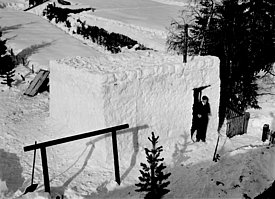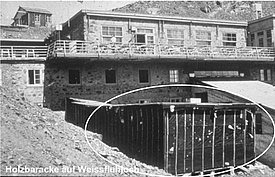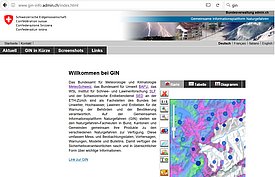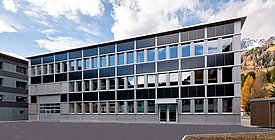
History ¶
From its origin in 1936 when a small group of researchers moved into the first snow lab on the Weissfluhjoch, the SLF has developed into a renowned research institute with nearly 150 employees in the Davos Valley. There have been various milestones along the way.
| 1931 | Chief Forest Inspector Marius Petitmermet, ETH School Board Chairman Arthur Rohn, and representatives from forest sciences, hydrology, railway construction and power plants found the Swiss Avalanche Commission in Bern, which is tasked with the evaluation of existing resources for avalanche observation in all of Switzerland. However, it quickly becomes clear that the scope cannot not be restricted to avalanches. It is also necessary to investigate the snow structure in order to improve understanding of avalanche formation processes. |
| 1935 | The commission, which has since been renamed the Snow and Avalanche Commission, sends a multidisciplinary research team led by Dr Robert Haefeli to Davos. In order to come to grips with the "extremely complicated relationships" of snow, they decide to investigate snow crystals in a cold laboratory under the most controlled conditions possible, as a basis for understanding avalanches. Accordingly, in December 1935 a small building measuring three by four metres with a height of slightly more than two metres is built entirely from snow in Davos Platz, to serve as a laboratory. |
| 1936 | A new laboratory and test area are set up on the Weissfluhjoch near Davos, at an elevation of 2662 metres, for research on snow metamorphism and avalanche formation. The Parsennbahn railway operator makes available a wooden hut and a workroom in the mountain station. The hut is buried underneath snow every winter and thus serves as a natural cold laboratory with a constant temperature of -5 to -7°C. |
| 1939 | Publication of the book "Der Schnee und seine Metamorphose". |
| 1942 | Founding of the Federal Institute for Snow and Avalanche Research, Davos-Weissfluhjoch , and in 1943, under the leadership of Dr Edwin Bucher, occupancy of the first institute building on the Weissfluhjoch. The principal fields of research remain the development of the snowpack, snow mechanics and avalanche formation, and the crystalline structure and metamorphosis of snow. |
| 1944 | Commissioning of the first cold laboratories. |
| 1945 | Transfer of responsibility for avalanche warnings from the Swiss Army. Between 1946 and 1950, establishment of a civilian avalanche warning service with twenty observation stations. Regular weekly avalanche bulletins are distributed by radio and newspaper for the emerging winter tourism industry. |
| 1950 | Dr Marcel de Quervain succeeds Dr Edwin Bucher as head of the institute. |
| 1950/51 | The extreme winter of 1950/51 claims 98 victims in Switzerland and heralds fundamental change. The catastrophic events call for action in the form of both basic research and practical support with shoring techniques and the avalanche warning service. Collaboration with the Swiss Meteorological Office (SMA) is stepped up to further increase the reliability of the avalanche bulletin. |
| 1953 | With the forest emerging as a key form of long-term avalanche protection, cooperation is established with the WSL, the Swiss Federal Institute for Forest, Snow and Landscape Research (then the EAFV) in Birmensdorf. Long-running joint projects are launched, including the Stillberg test site in the Dischma valley to investigate afforestation in an avalanche starting zone near the tree line. |
| 1955 | Adolf Voellmy, a scientist at EMPA, the Swiss Federal Laboratories for Materials Testing and Research, introduces the SLF to a treatise that allows the calculation of avalanches runout distances and dynamic compression forces. This provides a core basis for the design of protective structures in the avalanche track and runout zone (deflection barriers, snow sheds) and for the demarcation of avalanche danger zones in settlement areas. |
| 1956 | Construction of the snow chute alongside the institute to facilitate the practical study of dynamic processes. Experiments with the snow chute illuminate the flow behaviour of snow over short distances, the compression forces that arise upon impact with rigid obstacles, and the retardation effect of segmented obstacles. |
| 1960 | The SLF produces the first avalanche zone plan for the community of Wengen. |
| 1965 | First test of avalanche transceivers conducted at the SLF. |
| 1968 | The extreme winter of 1968 affects Davos especially severely. The institute is cut off for three weeks. |
| 1972 | The effects of explosions on the snowpack are examined. The analyses give rise to the publication of practical guidelines for triggering avalanches artificially. |
| 1973 | Start of investigations into quantitative avalanche forecasting and snowpack development on slopes (Gaudergrat test site). |
| 1980 | Dr Claude Jaccard takes over from Dr Marcel de Quervain as head of the institute. |
| 1983 | First measurements of avalanche speeds are taken in the Lukmanier region. |
| 1986 | The SLF celebrates 50 years of snow and avalanche research on the Weissfluhjoch.. |
| 1989 | The SLF becomes part of the WSL, the Swiss Federal Institute for Forest, Snow and Landscape Research. Since the amalgamation, the SLF has belonged to the domain of the ETH (Swiss Federal Institutes of Technology). |
| 1992 | Dr Claude Jaccard hands over leadership of the institute to Dr Walter Ammann |
| 1993 | The International Working Group of the European avalanche warning services establishes a milestone in the history of avalanche warning: for the first time, representatives of the European alpine countries agree on a uniform definition of avalanche danger levels. The five-level European Avalanche Hazard Scale is born. |
| 1995 | The WSL and the SLF open a branch office in Sion to provide a more direct response to the issues affecting the canton of Valais. |
| 1996 | At the end of November 1996, after 60 years of snow and avalanche research on the Weissfluhjoch, the institute's new building on Flüelastrasse in Davos Dorf becomes the headquarters of the SLF. The institute's former main building on the Weissfluhjoch remains at its disposal. The SLF initiates the development of the Intercantonal Measurement and Information System (IMIS), a network of snow and wind measuring stations. Today the IMIS comprises more than 160 measuring stations distributed over the entire Swiss alpine territory. |
| 1997/98 | In winter 1997/98 The Vallée de la Sionne test site for avalanche dynamics is commissioned. From winter 997/1998, the national avalanche bulletin is published every evening at 5 pm (in German) as a forecast for the next day. Staged introduction of regional avalanche bulletins, published every morning at 8am, starts with the Nordbünden and Mittelbünden regions. |
| 1999 | Avalanche disasters in February 1999 claim 17 victims in Switzerland, around six times less than in the comparable 1950/51 avalanche season. This proves the effectiveness of the successive protective measures taken since 1951. |
| 2002 | The Intercantonal Early Warning and Crisis Information System (IFKIS) for the avalanche warning services is commissioned at the SLF. |
| 2004 | Expansion of the SLF's activities focuses more acutely on other natural hazards. In conjunction with Birmensdorf, the modelling of dynamic processes is extended to embrace debris flows. At the same time, the development of warning and information systems for hydrological natural hazards in alpine valleys (torrents and debris flows) is initiated within the framework of pilot projects. |
| 2006/07 | The natural hazards research unit and its two sister units in the WSL, forestry and landscape, are dissolved in a restructuring exercise. The new organisation encompasses 16 research units. The various sites collaborate more closely than ever. Dr Walter Ammann is appointed deputy director of the WSL and later chairman of the International Disaster Reduction Conference (IDRC), and founds the Global Risk Forum. Dr Jakob Rhyner is appointed director of the Davos facility. |
| 2008 | The SLF adopts its new identity as a branch of the WSL Institute for Snow and Avalanche Research. |
| 2009 | The SLF conducts the first European International Snow Science Workshop (ISSW) in Davos. The Operational Snow Hydrology Service (OSHS) commences its bulletin operations |
| 2010 | Commissioning of GIN, the joint information platform for natural hazards developed by the SLF in collaboration with Meteo Switzerland and the Federal Office of the Environment. |
| 2011 | The SLF celebrates 75 years of snow and avalanche research with events throughout Switzerland. Dr Jakob Rhyner leaves the SLF to become Vice-Chancellor Europe of the United Nations University (UNU) and Director of the UNU Institute for Environment and Human Security in Bonn. Dr Jürg Schweizer is the new head of the SLF. |
| 2012/13 | To coincide with the start of the 2012/13 winter season, the SLF has thoroughly revised the avalanche bulletin format. The principal new aspects are two assessments a day (8am and 5pm) covering all regions in four languages, and a zoomable interactive danger map. For the first time, the description of the avalanche danger is compiled from a catalogue of standard phrases and produced simultaneously in all the languages. The avalanche bulletin is optimised for the Internet and smartphones. |
| 2013 | The interactive avalanche prevention platform "White Risk" developed by the SLF and SUVA goes online |
| 2016 | The Vallée de la Sionne facility celebrates its 20th anniversary, and the cooperation agreement between the Canton of Valais and the WSL is renewed. |
| 2018 | UNESCO includes the handling of the avalanche danger in the Representative List of the Intangible Cultural Heritage of Humanity. |
| 2019 | Former main SLF building on Weissfluhjoch sold to mountain railway company Davos Klosters Bergbahnen Ltd. |
| 2019/20 | Researchers from the SLF and WSL take part in the largest expedition to the Arctic to date: MOSAiC - Multidisciplinary drifting Observatory for the Study of Arctic Climate. They spend almost 13 months on the research vessel Polarstern. |
| 2020 | The SLF receives the King Albert Mountain Award and is honoured for its targeted commitment to avalanche prevention for the population and alpinism. |
| 2020 | Avalanche Bulletin celebrates 75th anniversary. The SLF issued its first avalanche bulletin on 21 December 1945. |
| 2021 | Start of the centre CERC Climate Change, Extremes, and Natural Hazards in Alpine Regions Research Center. The research centre contains six main research areas: (i) Weather and Climate Extremes in Alpine Regions, (ii) Permafrost, (iii) Remote Sensing, Early Detection and Early Warning, (iv) Alpine Mass Movements, (v) Mountain Ecology and Protective Forests, (vi) Risk Management, Risk Communication and Resilience. It is supported by the Canton of Grisons and the Swiss Federal Research Institute WSL and will be supported by ETH Zurich. |
| 2022 | In autumn, the replacement building will be occupied and officially opened. The new building D will provide more than 50 additional workspaces. These are urgently needed as the SLF has expanded considerably in recent years, in terms of both the issues it deals with and the number of personnel. The building meets the criteria for Minergie-P-ECO and has achieved the highest (Platinum) level of the Swiss Sustainable Construction Standard (SNBS). The World Meteorological Organization (WMO) has appointed the SLF to be the world's leading competence centre for snow monitoring. The WMO's Infrastructure Commission based its decision on the fact that the SLF already possesses high-quality measuring infrastructure and over 80 years of knowledge. |
Contact ¶
WSL Institute for Snow and Avalanche Research SLF
Flüelastrasse 11
CH-7260 Davos Dorf
Switzerland
Phone: +41 81 417 01 11
Avalanche Service: bulletin(at)slf.ch
General questions, student inquiries: contact(at)slf.ch
Media: medien(at)slf.ch
Webeditor: contact(at)slf.ch







